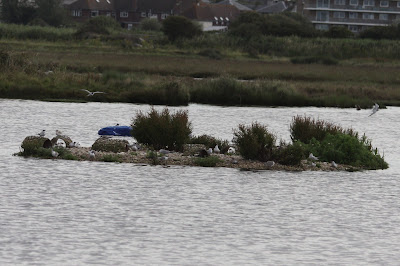As described on yesterday's post
the day the Olympic Torch arrived in Portland and Weymouth started with a
blaze of sunshine, blue, blue sky and a chill in the breeze. Ideal then
for a Beach Party, attention from the local media and a visitation from
a few superstars including former Olympic swimmer Sharon Davis.
While
neither Radipole or Lodmoor hold much magic for me these days, I
decided to set out at 06:00 to visit both. Having had so much rain, how
could anywhere not look 'green'
but Radipole particularly looked resplendent in its new growth of Common Reed.
Overhead c4 COMMON TERNs (there was a 4th) appeared to be squabbling at high altitude,
while
c5 GREAT CRESTED GREBEs cruised the Northern Lagoon. Not surprisingly
there were no young to be seen, probably washed out by last week's
flood? The beauty of PURPLE LOOSESTRIFE,
BUDDLEIA
and the un-strimmed verges was overshadowed by the most disgusting act I have ever witnessed at the reserve.
Suspected
of being breeding BLACK-HEADED GULLs washed out by the floods, these
birds have returned early to the lake. All else there were a few Common
Swifts, singing Reed, Sedge and Cetti's Warblers, equally vocal Reed
Buntings and a Water Rail. Onward to Lodmoor
via Greenhill Gardens and a fine example of the skills of out Council Gardens Department.
Out
in Weymouth Bay it looked more like Navy Days than the Olympic Games as
both HMS OCEAN (Great Britain's largest warship) and
HMS LANCASTER
a 'Duke' class Type 22 Frigate known as 'The Queen's Frigate'. the Duke
of Lancaster being one of the monarchs honorary titles, arrived for
their deployment as extra security for the Games. 'Ocean' was bound for
the Pool of London where she will act as Platform for Helicopter
Security at the Olympic Games.
Despite
the wet weather, COMMON TERNs on both nesting islands at Lodmoor
continue to thrive. That is not to say that some have not perished, but
there are still a good number being well provided for by parent birds.
In addition there were also c7 LAPWING (but distant), c5 OYSTERCATCHER, c2 Marsh Harrier, singles of Water Rail, Greenshank and
COMMON BLUE DAMSELFLY.
Otherwise there was a proliferation of LESSER REEDMACE (Bulrush) and a fine view of
the
Lodmoor Flood Plain from the high-ground close to Horselynch Copice.
Returning to Weymouth, the clouds were now gathering and bringing a high
prospect of rain.
The beach had been cleaned (as it is daily) for the arrival of the Torch
and lighting of the Cauldron later in the day
and
the stage was set for the Festival to follow. At 10:15 precisely the
rain once again showed its hand and at the time of retiring (bedtime) it
had continued to be persistent. There is not a thing that can be done
to combat this, but all the same my heart goes out to the 100's who have
put in 1,000's of hours preparation, the local youngsters waiting in
the wings to 'strut their stuff' and a lost opportunity to show the
world what the UK's No1 town is all about!



















